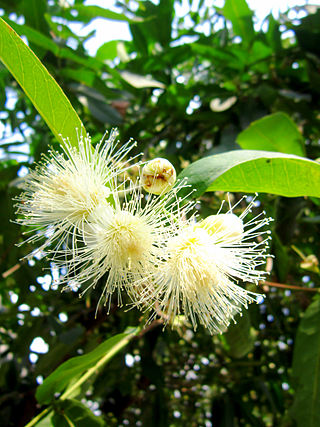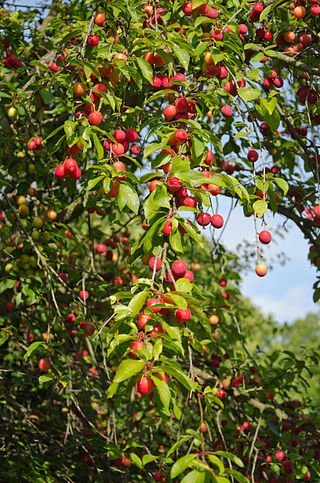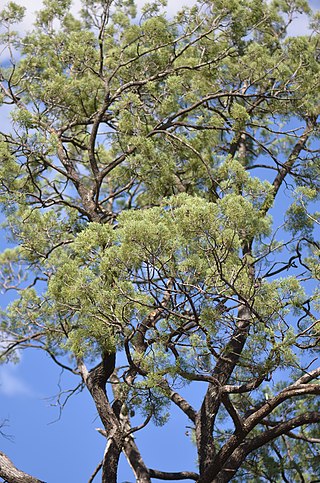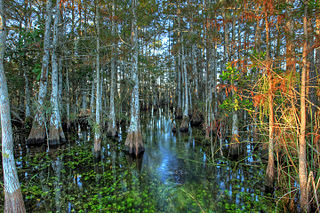
Dimocarpus longan, commonly known as the longan and dragon's eye, is a tropical tree species that produces edible fruit. It is one of the better-known tropical members of the soapberry family Sapindaceae, to which the lychee and rambutan also belong. The fruit of the longan is similar to that of the lychee, but less aromatic in taste. It is native to tropical Asia and China.

Ilex opaca, the American holly, is a species of holly, native to the eastern and south-central United States, from coastal Massachusetts south to central Florida, and west to southeastern Missouri and eastern Texas.

Syzygium samarangense is a species of flowering plant in the family Myrtaceae, native to an area that includes the Greater Sunda Islands, Malay Peninsula, and the Andaman and Nicobar Islands, but introduced in prehistoric times to a wider area and now widely cultivated in the tropics. Common names in English include wax apple, Java apple, Semarang rose-apple, and wax jambu.

Prunus cerasifera is a species of plum known by the common names cherry plum and myrobalan plum. It is native to Southeast Europe and Western Asia, and is naturalised in the British Isles and scattered locations in North America. Also naturalized in parts of SE Australia where it is considered to be a mildly invasive weed of bushland near urban centers. P. cerasifera is believed to one of the parents of the Cultivated Plum, Prunus domestica perhaps crossing with the sloe, Prunus spinosa, or perhaps the sole parent. This would make it a parent of most of the commercial varieties of plum in the UK and mainland Europe - Victoria, greengages, bullace etc.

Conocarpus erectus, commonly called buttonwood or button mangrove, is a species of mangrove shrub in the family Combretaceae.

Terminalia catappa is a large tropical tree in the leadwood tree family, Combretaceae, native to Asia, Australia, the Pacific, Madagascar and Seychelles. Common names in English include country almond, Indian almond, Malabar almond, sea almond, tropical almond, beach almond and false kamani.

Spondias purpura is a species of flowering plant in the cashew family, Anacardiaceae, that is native to tropical regions of the Americas, from Mexico to northern Colombia and the southwest Caribbean Islands. It has also been introduced to and naturalized to other parts of the American tropics, Southeast Asia, and West Africa. It is commonly known as jocote, which derives from the Nahuatl word xocotl, meaning any kind of sour or acidic fruit. Other common names include red mombin, Spanish plum, purple mombin, Jamaica plum, and hog plum.

Olea capensis, the black ironwood, is an African tree species in the olive family Oleaceae. It is widespread in sub-Saharan Africa: from the east in Somalia, Ethiopia and Sudan, south to the tip of South Africa, and west to Cameroon, Sierra Leone and the islands of the Gulf of Guinea, as well as Madagascar and the Comoros. It occurs in bush, littoral scrub and evergreen forest.

Avicennia germinans, the black mangrove, is a shrub or small tree growing up to 12 meters in the acanthus family, Acanthaceae. It grows in tropical and subtropical regions of the Americas, on both the Atlantic and Pacific Coasts, and on the Atlantic Coast of tropical Africa, where it thrives on the sandy and muddy shores where seawater reaches. It is common throughout coastal areas of Texas and Florida, and ranges as far north as southern Louisiana and northern Florida in the United States.

Diospyros nigra, the black sapote, is a species of persimmon. Common names include chocolate pudding fruit, black soapapple and zapote prieto. The tropical fruit tree is native to Mexico, Central America, and Colombia. The common name sapote refers to any soft, edible fruit. Black sapote is not related to white sapote nor mamey sapote. The genus Diospyros has numerous other fruit bearing tree species in addition to the persimmons and black sapote.

Callitris columellaris is a species of coniferous tree in the family Cupressaceae, native to most of Australia. Common names include white cypress, white cypress-pine, Murray River cypress-pine, and northern cypress-pine. Callitris columellaris has become naturalised in Hawaii and in southern Florida.

Prunus ilicifolia is native to the chaparral areas of coastal California, Baja California, and Baja California Sur. as well as the desert chaparral areas of the Mojave desert.

Carissa macrocarpa is a shrub native to tropical and southern Africa. It is commonly known as the Natal plum and, in South Africa, the large num-num. In Zulu, as well as in the Bantu tribes of Uganda, it is called Amathungulu or umThungulu oBomvu. In Afrikaans the fruit is called noem-noem.

Antidesma bunius is a species of fruit tree in the family Phyllanthaceae. It is native to South Asia, Southeast Asia, Melanesia, and northern Australia. It is commonly known as bignay, after its native name in the Philippines, where the fruits are commonly used for making bignay wine and jams. It is also known more ambiguously as Chinese laurel, Queensland cherry, salamander tree, wild cherry, and currant tree.

Chrysobalanus is a genus of evergreen perennial shrubs to small trees, described as a genus by Linnaeus in 1753. It is native to sub-tropical and tropical regions of Africa, Latin America, and Florida.

Flacourtia indica (known commonly as ramontchi, governor's plum and Indian plum, is a species of flowering plant native to much of Africa and tropical and temperate parts of Asia. It has various uses, including folk medicine, fuel, animal food and human food.

Chrysophyllum oliviforme, commonly known as the satinleaf, is a medium-sized tree native to Florida, the Bahamas, the Greater Antilles, and Belize. It is also known as damson plum, wild star-apple and saffron-tree. It gets the name "satinleaf" from the distinctive colors of the leaves. The top of the leaf is dark green while the bottom is light brown or copper. This distinctive look makes it a very aesthetically pleasing tree that is commonly used as an ornamental in yards and public spaces.

The south Florida cypress dome is a forested wetland plant community found in southern Florida, mostly in and around the Everglades and the Big Cypress National Preserve. They form in shallow depressions whose impervious substrates hold standing water for several months of the year.

Artocarpus sericarpus, the peluntan, pedalai, gumihan or terap bulu, is a tropical evergreen tree species of the family Moraceae. It is the cousin of jackfruit and breadfruit.
Paratachardina lobata, the lobate lac scale, is a polyphagous lac scale insect, which damages trees and woody shrubs. It is native to India and Sri Lanka, but has been introduced to Florida where it is regarded as an invasive species.
Bush, Charles S. and Morton, Julia F. (1969) Native Trees and Plants for Florida Landscaping (pp. 64–65). Bulletin No. 193. Department of Agriculture - State of Florida.


























